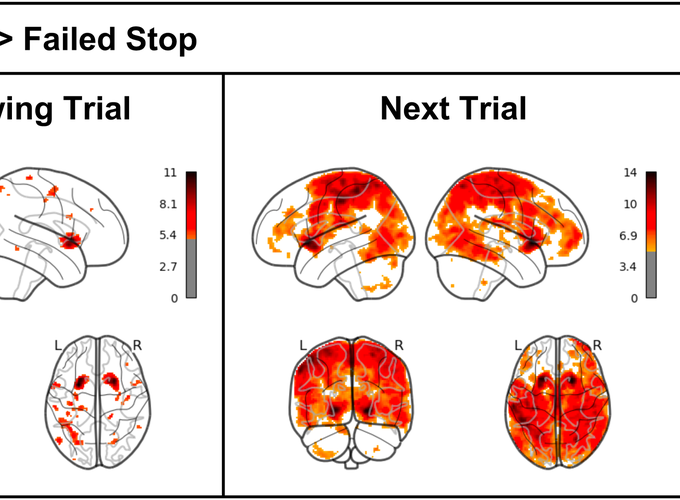Striatal response to negative feedback in a stop signal task operates as a multi-value learning signal

Striatal response to negative feedback in a stop signal task operates as a multi-value learning signal
Abstract
Background and aim: We examined error-driven learning in fMRI activity of 217 subjects in a stop signal task to obtain a more robust characterization of the relation between behavioral measures of learning and corresponding neural learning signals than previously possible. Methods: The stop signal task is a two-alternative forced choice in which participants respond to an arrow by pressing a left or right button but must inhibit that response on 1 in 7 trials when cued by an auditory “stop signal.” We examined post-error learning by comparing brain activity (BOLD signal) and behavioral responses on trials preceded by successful (correct stop) vs. failed (failed stop) inhibition. Results: There was strong evidence of greater bilateral striatal activity in the period immediately following correct (vs. failed) stop trials (most evident in the putamen; peak MNI coordinates [-26 8 -2], 430 voxels, p < 0.001; [24 14 0], 527 voxels, p < 0.001). We measured median activity in the bilateral striatal cluster following every failed stop and correct stop trial and correlated it with learning signals for (a) probability and (b) latency of the stop signal. In a mixed-effects model predicting activity 5-10 s after the stop signal, both reaction time (RT) change (B = -0.05, t = 3.0, χ2 = 11.3, p < 0.001) and probability of stop trial change (B = 1.53, t = 6.0, χ2 = 43.0, p < 0.001) had significant within-subjects effects on median activity. In a similar mixed model predicting activity 1-5 s after the stop signal, only probability of stop trial change was predictive. Conclusions: A mixed-effects model indicates the striatal activity might be a learning signal that encodes reaction time change and the current expected probability of a stop trial occuring. This extends existing evidence that the striatum encodes a reward prediction error signal for learning within the stop signal task, and demonstrates for the first time that this signal seems to encode both change in stop signal probability and in stop signal delay.